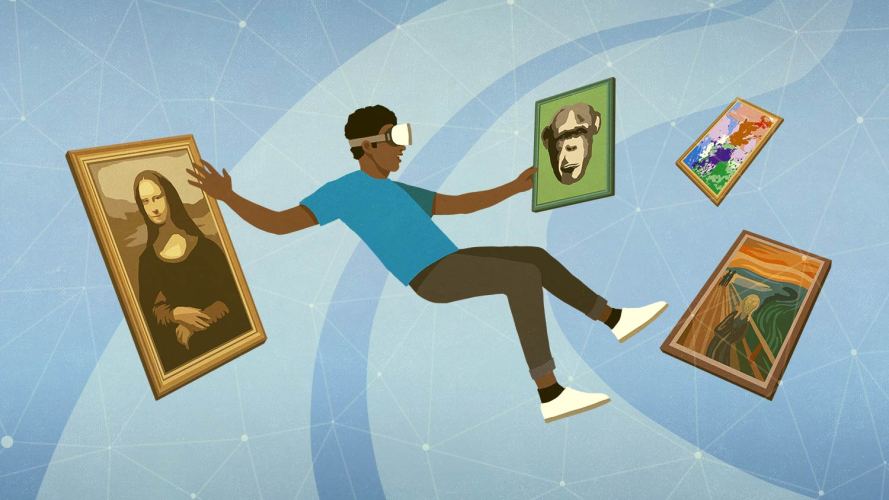What Is an NFT — And How Can It Help You Build Deeper Customer Relationships?

As Web3 continues to bubble up, businesses may wonder how to get involved — or if they should at all. Here’s a primer.
When an artist named Beeple sold a piece of digital art for $69 million in 2021 through a Christie’s auction, it raised eyebrows — mostly because it was an NFT. At the time, most people had never heard of this acronym. But in the last year cryptocurrencies, such as Bitcoin and Ethereum, continued to attract investors and more people embraced the decentralized ecosystem of Web3, the blockchain, and the metaverse — pushing this whole virtual world more into the mainstream. You may still wonder: What is an NFT and how can it help my business?
NFTs, or non-fungible tokens, come in many forms, but most people associate them with art or music. Brands like Adidas, Coca-Cola, and the NBA have offered these digital tokens as collectibles or keys to unlock events or exclusive promotions. While more businesses embrace NFTs, should you enter this new Web3 world? Here, we offer a primer to help make sense of NFTs and how they can benefit businesses.
What is an NFT?
First of all: fungible? Something that is fungible can be swapped or replaced with something identical. Something that is non-fungible is unique and can’t be replaced with anything else.
In the physical world, examples of fungible items are a dollar bill, a spiral notebook, or a gallon of milk. On the other hand, a Banksy painting is non-fungible since there’s only one. In the Web3 world, a bitcoin is fungible and can get replaced with another bitcoin.
NFTs, however, are digital tokens that represent digital files, such as photos, videos, and music, which could represent traditionally physical goods such as concert tickets or sneakers. They are created and stored on the blockchain (a digital ledger) to represent something distinctive or scarce.
You may also wonder about the difference between Web1, Web2, and Web3. In its most basic sense, Web1 allowed people to access and read information on websites, like Yahoo. In Web2, blogs, wikis, and social media like Twitter and YouTube got introduced, giving people more control over the information they created and shared. In Web3, the decentralized world puts ownership into the hands of the community.
Wow your customers wherever they are
With Salesforce Web3, customers can create deeper loyalty with their customers with a trusted, connected platform.



What can NFTs do for your business?
Products are no longer sold just in the physical world. A new generation of buyers is splitting its time between the physical, digital, and virtual worlds — and brands need to meet their buyers where they are. NFTs open doors to new markets, experiences, revenue streams, and brand relationships — giving brands the opportunity to increase revenue and open lines for community feedback.
You’ll continue to sell products in the physical world and on websites like Amazon or Target (Web1) and promote them on social media (Web2), but you can also sell NFTs in new digital-first marketplaces like the metaverse (Web3), likely in your own branded store. People can buy or earn NFTs to hold in a digital wallet or to sell or trade. Ultimately, it’s about deepening the brand-consumer relationship and building on loyalty and rewards programs.
NFTs also further your digital transformation and can create new revenue streams. For example, NFTs contain smart contracts that govern their use and can be set to execute at a certain point. A smart contract can dictate how long the asset must be held before it can be sold, how much it can be sold for, and what royalty the original creator retains on each sale. As a business, you can earn revenue, in perpetuity via a royalty, through a smart contract. Consumers can even “rent” your NFT to use in games and other activities. If they win and earn money, you split the earnings. The revenue streams at this point are plentiful and will continue to grow.
How are some brands using NFTs?
This all may sound confusing or overwhelming, so let’s talk about what some well-known brands are already doing in this space:
- Luxury fashion house Gucci created brand awareness by selling $12 digital sneakers to be “worn” in augmented reality (AR) like in the online gaming platform Roblox.
- Brewer Stella Artois offered 50 NFT horses that will race on a digital racetrack.
- Car manufacturer Alfa Romeo equipped its new SUV with an NFT that will track vehicle data to show proper maintenance over time.
- Coachella, the annual California music festival, launched an NFT marketplace where people bid on NFTs to unlock lifetime passes, unique on-site experiences, and physical and digital art.
What drives success with NFTs in the Web3 world?
Does entering this world and creating NFTs actually make sense for you? Do you have a community that wants what you’re offering? While you’ll continue to operate mostly in a Web2 environment for the foreseeable future, Web3 is decentralized, meaning the community works together and collaborates. It’s about co-creation and co-ownership.
Community drives success in this world. A brand first should identify a community to collaborate with on how to enter the market, otherwise it may get ignored and fail. This has already happened with a number of celebrity-crafted NFTs. So work with a community to help you create whatever it is you’re creating. Community will always be your best defense in Web3. This leads us to the next step: What utility does your NFT provide?
Many NFTs offer some sort of utility and have intrinsic value, whether monetary, access, perks, voting rights, and more. And they can be another revenue stream for businesses. For example, you can:
- Collaborate with artists or musicians to create NFT art.
- Use NFTs as special offers or keys to gain access.
- Mint digital assets people can display like a badge of honor.
- Create a real-life product extension like Louis Vuitton’s seal of authenticity.
- Offer legal ownership of intellectual property.
- Allow people to rent out NFTs for revenue.
How can you get started with NFTs?
So how do you get started and enter this new world? You can approach this in one of three ways:
- Low effort with little to no investment: If your company uses Slack, set up an internal channel for employees who demonstrate a passion for NFTs, crypto, blockchain, and more to discuss ideas and help you get set up or host virtual listening sessions.
- Medium effort with some investment: Start accepting crypto as payment for your goods and services. If you have a log-in to your website, allow people to log in with their digital wallet instead of a password. Or you can simply buy an NFT and hold on to it while also joining those communities and showing your commitment to Web3.
- High effort with significant investment: This is where you go all-in on NFTs and Web3. You can create an NFT project and work with an external community to build a roadmap to enter the market, where you sell NFTs on your branded marketplace.
This world is moving fast and changing even faster. Yes, there’s a lot to understand and learn, so take the time to do your research. NFTs won’t fit with every company, business, or organization. Do what makes the most sense for your company, customers and community. And then get ready to go down the NFT rabbit hole. It’s deep.
Get a 360° view of success
Vantage Point magazine brings together thoughtfully curated voices from the world’s most influential companies. Each issue unpacks intimate insights shaping the workplace.




























